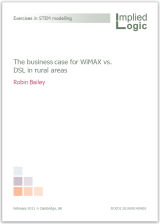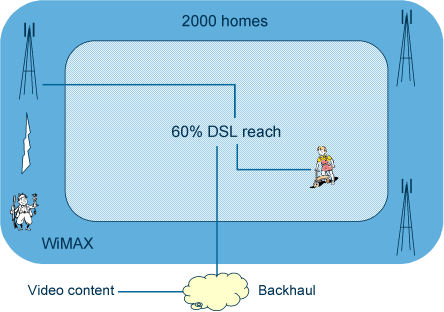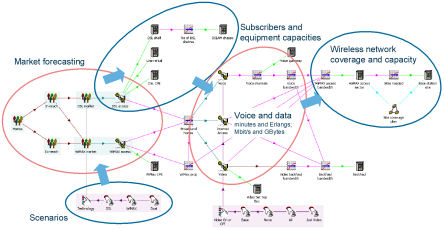In preparation for an ITU regional workshop on Network Planning for the Arab Region in Cario in July 2006, I was wondering: how to go
about explaining the fundamentals of business planning for telecommunications networks? This course is the result!
 A comprehensive
new training course is available, written around a demonstration
model, The business case for WiMAX vs DSL in rural areas. The
190-page exercise book presents 55 exercises in 15 groups covering all key features
of the STEM software and current modelling practices.
A comprehensive
new training course is available, written around a demonstration
model, The business case for WiMAX vs DSL in rural areas. The
190-page exercise book presents 55 exercises in 15 groups covering all key features
of the STEM software and current modelling practices.
The exercises build up essential skills by working through, and making various additions
to, a simple case study which compares WiMAX and DSL technologies for the provision
of broadband in a rural area.
This brand new exercise book has been written from scratch over the last 18 months
with a view to presenting an up-to-date and complete introduction to working with
STEM. The material makes full use of the latest STEM enhancements, and includes
features anticipated from the forthcoming release of STEM 7.2. The exercise
progression distils working knowledge gleaned from real-life problem solving for
existing users as well as countless demonstrations to customers exploring every
conceivable requirement.
This is now the standard STEM training book for all courses booked from 30 April
2008, and may offer a useful refresher opportunity for existing users, alongside
those learning STEM for the first time. Implied Logic offers both open training
sessions for multiple clients on demand, as well as the more traditional bespoke
course for closed groups.
Overview of the modelling context
This set of exercises looks at the deployment of broadband technologies in a rural
area network over 10 years from 2005. You will review a basic model and then
add detail to it as you learn about additional features within STEM.
Operators are considering broadband fixed wireless access (BBFWA) technologies such
as WiMAX as a more cost-effective solution for delivering IP-based services in low-density
subscriber areas. In the area under consideration there are 2000 homes connected
over conventional copper to a local exchange. In this rural area, some homes
are a significant distance from the exchange, and only 60% are within reach of the
current available DSL technology. WiMAX is suggested as an alternative broadband
solution.

The big picture
A network will be deployed during 2006, with the launch of commercial service scheduled
for January 2007. The model considers scenarios for each technology in isolation,
and also running both in parallel.
The business envisages WiMAX as a total replacement technology for the outlying
homes: voice and Internet services will both be carried over WiMAX for the relevant
subscribers. The model captures the revenue from these separate access platforms,
as well as from the individual services, and performs a high-level dimensioning
of the relevant network elements according the numbers of subscribers and associated
traffic levels.
The model also considers the addition of an IPTV service, and its impact on service
revenues and required network elements.
The model starts with a very simple network architecture, as follows:
- DSL or WiMAX CPE
- DSLAM (and line rental, if this is an alternative operator)
- WiMAX access sectors and base stations
- backhaul
- core network
- set-top box and video server.
Thus we have two different access technologies, but the same backhaul and core network
are used by both systems.

WiMAX-DSL model overview
Essential topics and a menu of advanced options
As you will see from the table of contents copied below, the exercises are grouped
in threes or fours under a number of broad topic headings designed to make it easier
to locate specific areas of functionality. This may be particularly helpful if you
return to this course as a reference guide in the future.
Sections 1–5 (exercises 1–17) cover the essential topics required to gain a reasonable
understanding of the core functions in STEM. You may be able to work through these
in one day, depending on your previous modelling experience. The remaining sections
6–15 (exercises 18–55) are intended as a menu of advanced options from which your
trainer can help you select the most relevant to your immediate requirements for
STEM.
You might choose to cover any skipped exercises during a break, or warm-up, during
a subsequent modelling workshop. Alternatively, you may wish to complete these
by yourself after the course as a consolidation exercise. Section 16 provides
some general tips for making this training last.
The full programme
1 Working with STEM
Exercise 1: Open the model in the Editor
Exercise 2: Explore the outputs in the Results program
Exercise 3: Modify an input and run the model
2 Subscribers and connections (DSL ports)
Exercise 4: Forecast demand and equipment installation
Exercise 5: Geographical deployment
Exercise 6: Capex, depreciation and operating costs
3 Call minutes and Erlangs; GBytes and Mbit/s
Exercise 7: Volume-driven traffic model for voice
Exercise 8: Peak-driven traffic model for data
Exercise 9: Adding scenarios
Exercise 10: Dimensioning for video streams
4 Bandwidth dimensioning and coverage (WiMAX sectors)
Exercise 11: Creating an Expression Transformation
Exercise 12: Sectors and base stations
Exercise 13: Coverage model
Exercise 14: Help and auditing
5 Financial elements – operating results
Exercise 15: Understanding the difference between cashflow and profit
Exercise 16: Adding sub-totals with Collections
Exercise 17: Performing sensitivity analysis in STEM
Advanced topics
6 Integration with Excel
Exercise 18: Linking simple inputs from Excel
Exercise 19: Linking a time-series input from Excel
Exercise 20: Exporting model data to Excel
Exercise 21: Pulling STEM results back into Excel
Exercise 22: Running a STEM model from Excel
7 Equipment installation and migration
Exercise 23: End-of-life replacement with a functional equivalent
Exercise 24: Pro-active migration to a better solution
Exercise 25: Accounting for redundant units
Exercise 26: Existing equipment and pre-run installation
8 Total cost of ownership
Exercise 27: Understanding the built-in operating cost attributes
Exercise 28: Defining cost trends for all, and for individual, resources
Exercise 29: Varying costs with the age of a resource
Exercise 30: End-of-life costs, disposal of assets, and adjustments
9 Market sizing
Exercise 31: Adding custom inputs and formulae
Exercise 32: Testing the market model
Exercise 33: WiMAX as a disruptive technology
Exercise 34: A more dynamic market model
10 Delivery model for video
Exercise 35: Video bandwidth for access and for backhaul
Exercise 36: Adding the video server (bandwidth)
Exercise 37: An Erlang model for video dimensioning
Exercise 38: Re-defining the server capacity (streams)
11 Geographical scope and diversity
Exercise 39: The macro-economic approach
Exercise 40: Site-by-site calculation the hard way
Exercise 41: Template replication and geo-types
Exercise 42: Adding regional aggregation with Collections
Exercise 43: Aggregating the output of a template
12 Financial elements – funding the business
Exercise 44: Working Capital
Exercise 45: Interest, tax and dividends
Exercise 46: Funding an investment
Exercise 47: Financial instruments (debt facilities)
13 Service costing and profitability analysis
Exercise 48: Cost allocation and breakdown by element
Exercise 49: Overriding the automatic cost-allocation keys
Exercise 50: Value chains and layered costs
14 Icons, links, colour blocks and text boxes
Exercise 51: Controlling how data is presented in a view
Exercise 52: Adding titles or annotation to a view
15 Copying and printing data and graphics
Exercise 53: Copying model data and elements
Exercise 54: Exporting graphics to other applications
Exercise 55: Printing model data and graphics
16 How to make this training last
Identifying the elements of a STEM business model
17 Tips for running this training course
18 Detailed description of the modelling context
Re-building the model from scratch
Stronger candidates may try building a simplified model in parallel from scratch.
Start with DSL and WiMAX sub-models (driven by generic ports and bandwidth respectively).
Then add the service breakdown, and the market layer, together with the basic technology
scenarios.
This exercise will provide valuable experience of working from a blank sheet, which
will lower the fear factor when you start on your first real model. It will also
allow you to experiment freely with multiple views and the copy and paste functions
more flexibly than is allowed by the straight-jacket of the core exercises.